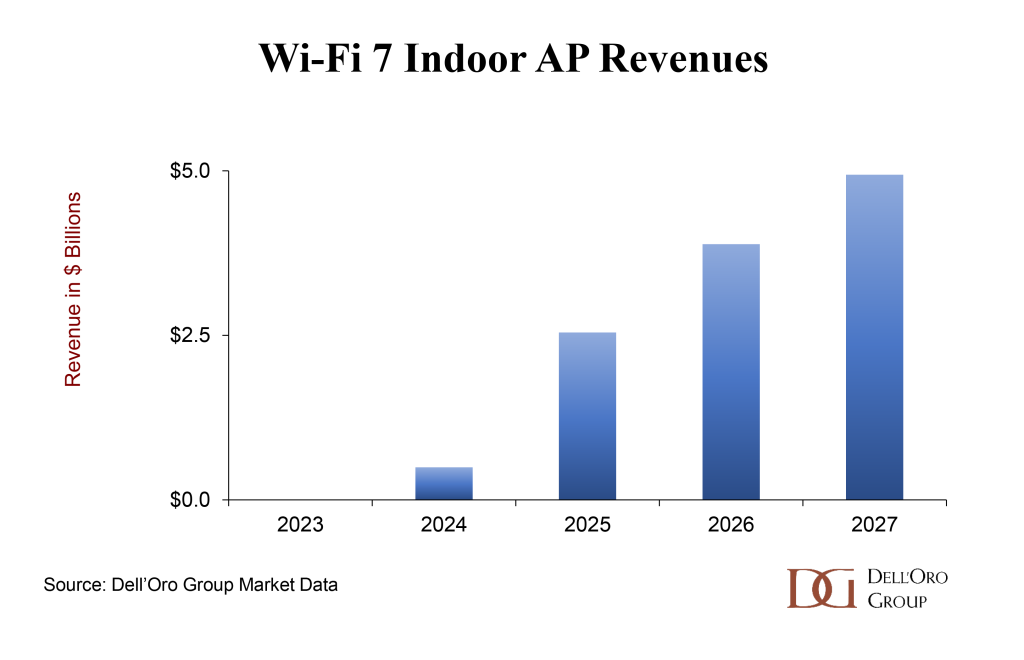Today, CommScope announced an enterprise-class, Wi-Fi 7 Access Point (AP), making the company the largest enterprise-class WLAN vendor outside China to announce an AP that supports the cutting-edge standard. When the R770 begins shipping in December it will take its place on the Wi-Fi 7 shelf with APs from H3C that are already shipping, from Huawei that have been delivered to over 50 customers, and from EnGenius that are expected to ship in November. HFCL has also promised several OpenWiFi Wi-Fi 7 APs, although none of them support the new 6 GHz band.
For some in the industry, these announcements seem early, since the standard underlying Wi-Fi 7, named 802.11be, is not expected to receive the IEEE’s official stamp of approval until 2024. The Wi-Fi Alliance has not announced a timeline for its AP certification process, either.
This fact did not stop today’s announcement by CommScope, who released details of the new AP which is based on a Qualcomm chipset. CommScope Ruckus representatives confirmed to us that the company will begin selling the R770 before it has been certified and begin certification as soon as the process is available.
Now that the new Wi-Fi standard is a reality, it is legitimate to ask the question: What value are enterprises really going to get from upgrading to Wi-Fi 7?
This time around, the IEEE has spun its magic to obtain much higher speeds than previous generations of WLAN technology. 802.11be was labeled “Extremely High Throughput” and, in theory, brings 5 times more throughput compared to 802.11ax, which was commercialized as both Wi-Fi 6 and Wi-Fi 6E. Speed improvements have been made possible by the introduction of a higher order modulation scheme and wider channels, among other innovations.
In reality, throughput speeds will not match the theoretical maximums and will depend on several variables. The maximum data transfer rates of the newly announced Wi-Fi 7 APs are two to four times the rates of similar Wi-Fi 6 products, which gives enterprises an idea of the improvements they can realistically target.
The ability to improve data rates will be a boon for enterprises who are experiencing Wi-Fi congestion as their employees return to the office, relying heavily on videoconferencing applications. But Wi-Fi 7 will bring more than just higher bandwidth. Evolved security, lower latency and enhanced power efficiency could also push an enterprise to upgrade its Wi-Fi network.
One of the headline features of 802.11be, called MLO or Multi-Link Operations, has been the subject of several academic papers. Tests have demonstrated that the ability to communicate over multiple radio interfaces (for example by switching rapidly between bands) lowers latency and increases reliability. CommScope has jumped on this advancement. The R770 supports MLO across all three frequency bands: the legacy 2.4 GHz and 5 GHz bands as well as the freshly minted 6 GHz. However, it is important to consider that MLO needs to be supported on both the AP and the end device.
On the device side, several smartphone manufacturers have announced Wi-Fi 7 in their line-up, and some of them explicitly call out MLO. Xaiomi was early to the Wi-Fi 7 market with the M13 Pro and other manufacturers have followed suit, with the most recent announcement from Google, adding the Pixel 8 and Pixel 8 Pro to the Wi-Fi 7 device list.

As enterprises upgrade their Wi-Fi networks to the latest generation, they will need to think about more than acquiring new APs. The availability of switch ports and the cabling infrastructure is of particular importance, as all of the Wi-Fi 7 APs introduced to the market so far have a 10 Gbps port to connect the AP to the switch. This will be a fundamental change for many organizations, whose APs currently have uplinks that range between 1 and 5 Gbps. Many enterprises will need to upgrade cabling infrastructure to Cat 6A and may find the distance limitation of 100 meters (328 feet) problematic. Huawei’s AirEngine 8771-X1T also has a fiber 10 Gbps port, opening the possibility for enterprises to lay optical cable or a combined fiber-electrical cable.
The value of Wi-Fi 7 is in the higher order modulation and in the MLO, but most of all in the access to the new 6 GHz frequency band. Enterprises that operate in regions of the world whose regulators have freed up the whole 6 GHz band – such as North America, Brazil, and Saudi Arabia, have the most to gain. Enterprises in countries where unlicensed use of the 6 GHz band is not permitted, such as China and India, will benefit from incremental improvements without the lower congestion and larger channel widths introduced with the new frequency.
Sales of Wi-Fi 7 APs are expected to remain relatively small in 2023 and will begin to become material next year – a year that may be difficult for some Wireless LAN manufacturers. After living through two years of component shortages and ballooning backorders, manufacturers have released a huge wave of enterprise-class WLAN APs in the past three quarters. We expect 2024 will be a digestion period, a pause while enterprises deploy their equipment and distributors clear the excess inventory from the channel. If this scenario plays out as we expect, Wi-Fi 7 sales may be the bright spot of the year, enticing enterprises to refresh old networks with higher-priced, cutting-edge equipment.
While the vendors are gearing up for new sales, the industry as a whole is busy developing new use cases for the Extremely High Throughput Wi-Fi. The Wireless Broadband Alliance (WBA) and its partners have documented their vision that by supporting higher speeds, lower latency, and higher density deployments, Wi-Fi 7 will play a pivotal role in the Enterprise Metaverse and Industrial IoT. The industry organization is also actively collaborating with its members to conduct field trials of these technologies in real-life Wi-Fi 7 networks.
A recent discussion with Bruno Thomas, CTO of the WBA, served to emphasize the innovation that the new protocol will bring to the market. “Wi-Fi 7 will enable enterprise use cases that have been impractical or impossible with other wired of wireless technologies. It will drive innovation…in vertical sectors like healthcare for telemedicine, and within industrial settings for machine-to-machine communication, remote monitoring and predictive maintenance.” In other words, we are on the doorstep of a critical intersection. Technological advances have combined with a brand-new frequency band, and enterprise connectivity has leapt into the future.

